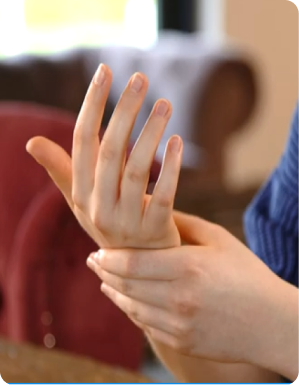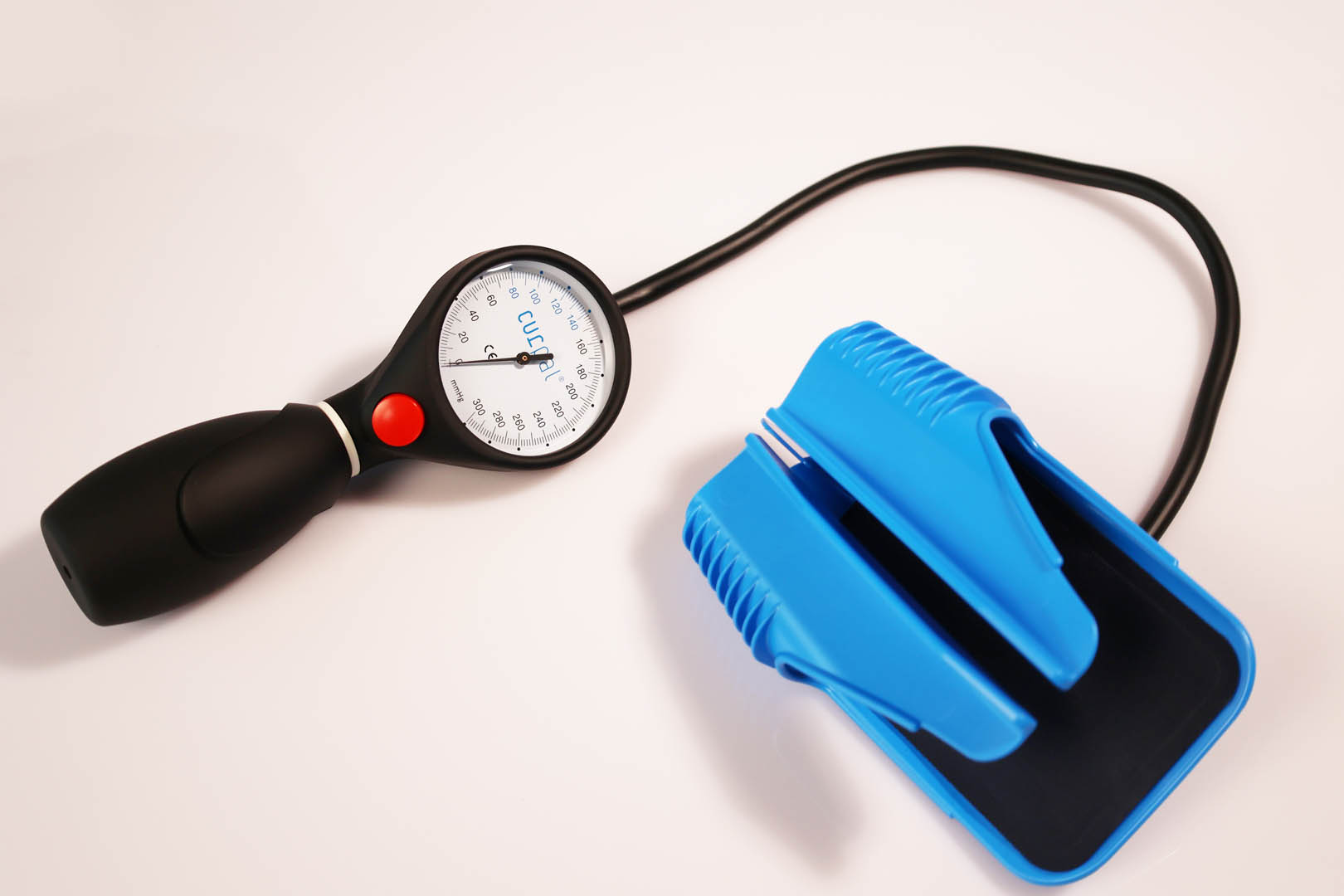Palm pain - a common sign of carpal tunnel syndrome (CTS), a common condition that causes pain and numbness in the hands and fingers.
It is caused by pressure on the median nerve in the wrist, which runs through the carpal tunnel. The symptoms can be distressing and have a significant impact on quality of life. It is therefore important to know effective methods to relieve the symptoms. In this article, we will present five effective methods for carpal tunnel syndrome. These methods can help you to relieve the pain quickly and restore the function of your hand.
Whether you have pain in the thumb joint and ball of the thumb, pain in the back of the hand or pain in the hand from overuse, these methods can help you regain control of your health.

Balls of the hand hurt? What is carpal tunnel syndrome?
Carpal tunnel syndrome is a condition caused by pressure on the median nerve in the wrist. This nerve is responsible for the sensations in the thumb, index finger, middle finger and part of the ring finger.
If the nerve becomes pinched or irritated, this can lead to pain, numbness and weakness in the hand or pain in the ball of the hand.
These symptoms can develop gradually and are often worse during the night.
The main causes of carpal tunnel syndrome are:
- Repetitive hand and wrist movements that strain the nerve
- Pregnancy and other conditions that lead to fluid retention in the body
- Medical conditions such as diabetes, rheumatoid arthritis and hypothyroidism
- Injuries to the wrist or hand
- Genetic factors, as some people have a smaller carpal tunnel
It is important to recognize and treat carpal tunnel syndrome early to avoid permanent nerve damage.
Recognizing symptoms of carpal tunnel syndrome
The symptoms of carpal tunnel syndrome can vary, but they usually start gradually and worsen over time.
The first signs often include discomfort at night.
Many people notice that they wake up at night because they feel pain, tingling or numbness in their hand.
These symptoms can also occur during activities that put strain on the wrist, such as holding a book or driving.
The most common symptoms of carpal tunnel syndrome are:
- Pain in the hand and wrist that can spread to the arm
- Tingling or numbness in the fingers or hand
- Weakness in the hand that makes it difficult to grip objects
- A feeling as if the hand has "fallen asleep"
- Pain or discomfort that worsens at night
It is important to see a doctor if you experience these symptoms. Early diagnosis and treatment can help prevent permanent nerve damage.
Causes and risk factors for carpal tunnel syndrome
Carpal tunnel syndrome occurs when the median nerve, which runs from the forearm through the carpal tunnel into the hand, is pinched or compressed.
This nerve is responsible for the sensations in the fingers and for the movement of the small muscles in the hand.
When the carpal tunnel, a narrow passage of bone and ligaments at the wrist, comes under pressure, this can affect the median nerve and cause the symptoms of carpal tunnel syndrome.
There are several factors that can increase the risk of developing carpal tunnel syndrome:
- Repetitive hand and wrist movements, especially if the wrist is in an unnatural position
- Certain health conditions, such as diabetes, rheumatoid arthritis and hypothyroidism
- Pregnancy, due to fluid retention in the body
- Age, as the risk increases with age
- Genetics, as people with smaller carpal tunnels may have a higher risk
It is important to be aware of these risk factors and try to minimize them to reduce the risk of developing carpal tunnel syndrome.
First aid: quick measures for acute pain
If you suddenly feel severe pain in your wrist or hand, there are a few things you can do immediately.
These measures can help to relieve the pain and prevent further damage.

Cold and heat applications
One way to relieve pain and swelling is to apply cold.
You can apply an ice pack or cold pack to the affected area to reduce inflammation.

Elevation and rest
Another important measure is to elevate the hand.
This can help to reduce the swelling and relieve the pressure on the nerve.
Anti-inflammatory medication
Finally, anti-inflammatory medication such as ibuprofen can help to relieve the pain and reduce inflammation.
However, it is important to only take these medications after consulting a doctor.
Long-term treatment methods
In addition to quick measures to relieve pain, there are also long-term treatment methods for carpal tunnel syndrome. These methods aim to alleviate the symptoms and prevent the disease from progressing.
Wrist splints and ergonomics
One of the most effective long-term treatment methods is the use of wrist splints. These splints can help to keep the wrist in a neutral position, reducing pressure on the nerve. Here we recommend curpal, an approved medical product made in Germany.
Ergonomics at the workplace are just as important. An ergonomic design of your workplace can help to reduce the strain on your wrists and minimize the risk of symptoms.
Exercises for carpal tunnel syndrome
There are also specific exercises that can help to alleviate the symptoms of carpal tunnel syndrome. These exercises aim to improve the flexibility and strength of your wrists and hands.
Some of the most effective exercises are tendon gliding exercises, nerve gliding exercises, stretching exercises and strengthening exercises.
Exercise 1: Tendon glide exercise
Tendon gliding exercises can help to improve the mobility of your tendons and relieve the symptoms of carpal tunnel syndrome.
Exercise 2: Nerve gliding exercise
Nerve gliding exercises aim to improve the mobility of the nerve and thus relieve the symptoms.
Exercise 3: Stretching exercise for wrist and fingers
Stretching exercises can help to improve the flexibility of your wrists and fingers and thus alleviate the symptoms of carpal tunnel syndrome.
Exercise 4: Strengthening exercise for forearm muscles
Strengthening exercises can help to strengthen the muscles in your forearm and thus alleviate the symptoms of carpal tunnel syndrome.
Alternative therapy approaches
In addition to the methods mentioned above, there are also alternative therapy approaches that can be helpful in the treatment of carpal tunnel syndrome.
These include acupuncture, yoga and other forms of bodywork that can help to alleviate symptoms and improve overall hand health.
When is surgery necessary?
In some cases, conservative treatment methods may not be enough to relieve the symptoms of carpal tunnel syndrome. If the pain and discomfort persists or worsens despite treatment, surgery may be necessary.
The surgery, known as carpal tunnel release, aims to reduce the pressure on the nerve by cutting the ligament that forms the carpal tunnel. This can help to relieve symptoms and prevent further nerve damage.
It is important to note that surgery should always be a last resort and should only be considered if other treatment methods have been unsuccessful. A thorough discussion with your doctor is crucial to determine the best course of action for your specific situation.
Prevention: How can you prevent carpal tunnel syndrome?
Prevention of carpal tunnel syndrome begins with understanding the risk factors and taking steps to minimize those risks. This can include adjusting your work environment, changing your handling habits and performing exercises to strengthen your hand and wrist muscles.
It is also important to look out for the early signs and symptoms of carpal tunnel syndrome and seek medical help early. Early diagnosis and treatment can help slow the progression of the condition and reduce the likelihood of permanent nerve damage.
Finally, a healthy lifestyle, including regular exercise, a balanced diet and adequate hydration, can help reduce the overall risk of health problems, including carpal tunnel syndrome.
Summary and further resources
Carpal tunnel syndrome is a common condition that can cause pain and discomfort in the hand and wrist. However, there are many effective ways to relieve symptoms, from quick pain relief measures to long-term treatment strategies and exercises.
For more information and support in coping with carpal tunnel syndrome, the following resources may be helpful:






Leave a comment
This site is protected by hCaptcha and the hCaptcha Privacy Policy and Terms of Service apply.